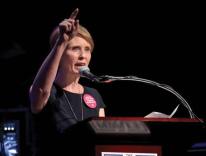Remember 1958! That’s the rallying cry of organized labor in California as it approaches a June 2 primary election that could determine the union movement’s political future, not only in California but elsewhere. Labor will focus most of its political energies on defeating Proposition 226, dubbed by proponents the "Paycheck Protection Act,"enactment of which would require that unions gain yearly permission from their members to spend members’ dues in political campaigns.
On the surface, the Paycheck Protection Act has an obvious appeal. Why shouldn’t members be able to decide whether unions can use their dues for political purposes? The reality is that the typical union member contributes about $20 a year that goes for political purposes. That amount offers an individual little in the way of political influence, but wielded collectively, these funds make organized labor a significant player in politics. In 1992, a similar measure restricting unions passed in Washington state. Since then, political contributions to state AFL-CIO unions have declined by 40 percent, and in 1994, conservatives took control of the state legislature.
California’s Proposition 226 is a model of hypocrisy. It would not require corporations to get shareholders’ permission before making corporate campaign contributions or lobbying for specific billsÑbusiness interests already outspend labor by ten to one in state races, not including corporate-dominated "soft"moneyÑbut it would make it nearly impossible for unions to raise substantial funds for political purposes such as TV ads, direct mail, and get-out-the-vote efforts. Thus, Proposition 226 is aimed at the heart of the progressive coalition. Why? Two years ago, the state’s unions played a key role in California’s legistlative races. Labor mobilized members in an unprecedented grassroots effort and helped restore thin Democratic majorities in both houses.
For Republicans, Proposition 226 is more than a vehicle to undercut union influence. They view Proposition 226 as a linchpin of their long-term strategy, for without labor’s political influence, Democrats will be hard-pressed to maintain their control of the California legislature, or elect a Democrat governor this fall. Furthermore, whatever party has control of California politics will oversee the next congressional reapportionment following the 2000 census. For the national GOP, orchestrating the redistricting of California’s likely fifty-five congressional seats is a prerequisite to controlling the House.
Not since 1958 has labor’s institutional strength come under such a direct attack. In the mid-1950s, labor had reached the pinnacle of its size and economic clout nationally, representing over one-third of American workers. Corporate America counterattacked with so-called "Right-to-Work"initiatives, which it helped place on the ballot in six states. The initiatives, which sought to allow employees to benefit from the gains of union contractsÑhealth benefits, shorter work hours, increased wagesÑbut without having to pay dues or even join the union, were designed to put unions out of business.
The most visible battle over "Right-to-Work"laws took place in California in 1958. Unions went to unprecedented lengths to defeat the measure. Early on in the campaign, polls showed that the average voter was in favor of the concept of the right to work, a phrase that was as vague as it was politically clever. To shift the tide, the state AFL-CIO raised additional funds from its members. It worked with civic, religious, and community leaders to form a "Citizens Committee against Right-to-Work,"which directed a well-crafted message to the nonunion public, linking labor’s fate with the preservation of Social Security, increasing the minimum wage, and fighting for public education.
Conservative forces in California were represented by U.S. Senator William Knowland, the former publisher of the Oakland Tribune and the Republican nominee for governor. Knowland made "Right-to-Work"a dominant theme throughout the gubernatorial campaign, telling anyone who would listen that the real issue was "union democracy."His Democrat opponent, Attorney General Edmund G. "Pat"Brown, argued that "Right-to-Work"diverted voters from the real challenges facing California. Brown won and "Right-to-Work"lost by a two-to-one margin.
As with the battle of 1958, the conflict over Proposition 226 is reverberating in this year’s governor’s race. Attorney General Dan Lungren, the Republican candidate, has announced his support while all three of the Democratic primary candidates have stated their opposition. But unlike 1958, the current Democrats are unlikely to campaign hard against 226, at least until polls indicate that to do so would be a vote-getter.
But there are other parallels between 1958 and today, particularly on the national level. Throughout 1957 and early 1958, Senator John McClellan (D-Ark.) held hearings into union corruption and mob influence, attracting widespread national attention. His committee concluded that millions of dollars of union funds had been embezzled, and that violence was rife in some unions.
Today, as the labor movement seeks to rebuild after decades of decline, its opponents are again mounting a counter-offensive. Although AFL-CIO President John Sweeney, elected two years ago as an activist reformer, has pledged a new era of grassroots organizing, his efforts have been partly thwarted by a new wave of allegations of union corruption, and by a Republican national political agenda designed to throttle labor’s political comeback. Congressman Peter Hoekstra (R-Mich.) has held hearings into the allegations of election fraud in the 1996 Teamsters election, and has issued subpoenas to other unions and to the Democratic National Committee. The hearings are likely to heat up again to coincide with the election cycle. And Republican House and Senate leaders Newt Gingrich and Trent Lott have pledged to kill any campaign finance reform law that does not include restrictions on union political contributions (the federal level "Paycheck Protection Act,"on which Proposition 226 is modeled).
California is not the first test case for initiatives designed to restrict labor’s political power. In fact, currently there is similar legislative activity ongoing in every state. But as in 1958, California is the crucial battleground. When "Right-to-Work"was defeated there, it was a major setback in the "open shop"march across the country.
Unions have an uphill battle in California. A statewide Field Poll taken in March found that 60 percent of registered votersÑincluding the same percentage of union membersÑfavored Proposition 226. Still, the anti-226 forces have some advantages. First, when voters are confused about what an initiative means, historically they tend to vote no. Since 1911, two-thirds of statewide initiatives in California have gone down to defeat. Second, the "no"forces will draw attention to Proposition 226’s major backers, including J. Patrick RooneyÑCEO of Golden Rule Insurance Company of Indiana and one of Newt Gingrich’s strongest alliesÑand Grover Norquist of the right-wing Americans for Tax Reform. So far, major California business leaders have remained on the sidelines; although not pro-union, many are uncomfortable being in the company of what they consider the right-wing fringe. It remains to be seen whether outgoing Governor Pete Wilson, chairperson of the Proposition 226 Campaign Committee, can bring the business community on board.
The fight for Proposition 226 will be won or lost on television, where most voters get their information. The California State AFL-CIO estimates it will take $10 million to run an effective media campaign. But that will not be enough. Labor will also have to mount an aggressive grassroots effort that reaches beyond its own members. Weaker politically and numerically than in 1958, labor needs to broaden its support beyond its membership and persuade enough voters that the defeat of 226 is key in protecting their standard of living. For if Proposition 226 passes, environmentalists, senior citizens, advocates for children and the disabled, supporters of affordable housing, civil rights, and women’s rights groupsÑas well as champions of public schools and higher education will all find themselves much weaker politically. More than any other liberal group, organized labor has the resources of money and members to help elect candidates generally sympathetic to progressive causes. While unions have been reaching out to find these new allies, unlike forty years ago, so far high-profile figuresÑclergy, education leaders, civil rights activists, civic leaders, and othersÑhave not played a significant role in the fight against Proposition 226. With so much at stake, labor has to convince others that they too are fighting for their lives.
Please email comments to [email protected] and join the conversation on our Facebook page.
Previous Story
A fearless voice: Denise Levertov
Next Story
The Popes against the Jews

